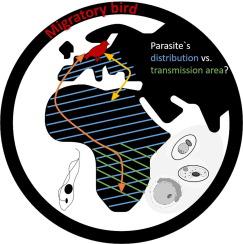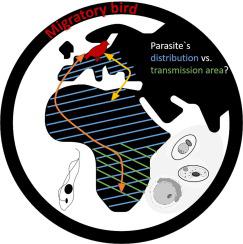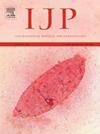Parasite airlines: mapping the distribution and transmission of avian blood parasites in migratory birds
IF 3.7
2区 医学
Q1 PARASITOLOGY
引用次数: 0
Abstract
During their journeys, migratory birds encounter a wider range of parasites than residents, transporting them over vast distances. While some parasites are widely distributed, transmission is not inevitable and depends on the presence of competent arthropod vectors as well as parasite compatibility with native bird species. Distinguishing between parasite distribution and transmission areas is crucial for monitoring and assessing risks to native bird species, as distribution areas, with the appropriate conditions, could become potential transmission areas. In this study, blood samples from 455 reed-living birds of the genera Acrocephalus, Locustella, and Emberiza, collected in the nature reserve “Die Reit” in Hamburg, Germany were screened, targeting haemosporidian parasites, trypanosomes, and filarioid nematodes. Determination of migratory bird age was employed to ascertain the transmission area of the detected parasites. Transmission areas were determined, based on information provided by resident and juvenile birds as well as findings in competent vectors. Long-distance migratory birds of the genus Acrocephalus showed a higher prevalence and diversity of blood parasites compared with partially migratory birds such as Emberiza schoeniclus. Notably, an age-dependent difference in parasite prevalence was observed in Acrocephalus spp., but not in E. schoeniclus. Nematodes were absent in all examined bird species. Proposed transmission areas were identified for nine haemosporidian lineages, showing three different types of transmission area, either with limited transmission in Europe or Africa, or active transmission in both regions.


寄生虫航线:绘制候鸟血液寄生虫的分布和传播图。
候鸟在旅途中会遇到比本地鸟类更多的寄生虫,并将它们带到很远的地方。虽然有些寄生虫分布广泛,但传播并非不可避免,这取决于是否存在有能力的节肢动物媒介以及寄生虫与本地鸟类物种的兼容性。区分寄生虫分布区和传播区对于监测和评估本地鸟类面临的风险至关重要,因为分布区在适当的条件下可能成为潜在的传播区。本研究对在德国汉堡 "Die Reit "自然保护区采集的 455 只芦苇属鸟类的血液样本进行了筛查,目标是血孢子虫寄生虫、锥虫和丝状线虫。通过确定候鸟年龄来确定检测到的寄生虫的传播区域。根据留鸟和幼鸟提供的信息以及合格病媒的调查结果确定传播区域。与Emberiza schoeniclus等部分候鸟相比,Acrocephalus属的长途迁徙鸟类血液寄生虫的流行率和多样性更高。值得注意的是,在 Acrocephalus 属鸟类中,寄生虫的流行率与年龄有关,而在 E. schoeniclus 中则没有。所有检查过的鸟类都没有线虫。为九个血孢子虫品系确定了拟议的传播区域,显示出三种不同类型的传播区域,要么在欧洲或非洲传播有限,要么在这两个地区传播活跃。
本文章由计算机程序翻译,如有差异,请以英文原文为准。
求助全文
约1分钟内获得全文
求助全文
来源期刊
CiteScore
8.40
自引率
2.50%
发文量
76
审稿时长
23 days
期刊介绍:
International Journal for Parasitology offers authors the option to sponsor nonsubscriber access to their articles on Elsevier electronic publishing platforms. For more information please view our Sponsored Articles page. The International Journal for Parasitology publishes the results of original research in all aspects of basic and applied parasitology, including all the fields covered by its Specialist Editors, and ranging from parasites and host-parasite relationships of intrinsic biological interest to those of social and economic importance in human and veterinary medicine and agriculture.

 求助内容:
求助内容: 应助结果提醒方式:
应助结果提醒方式:


